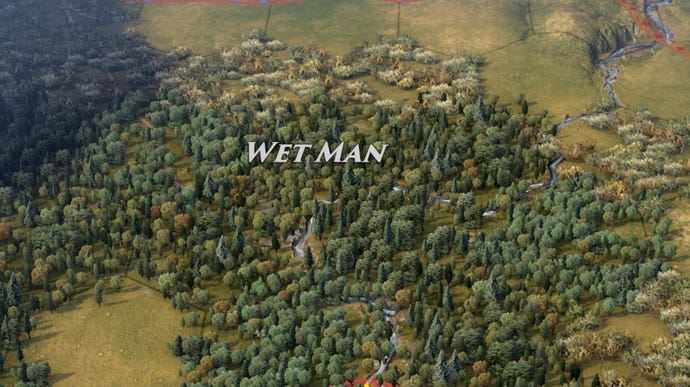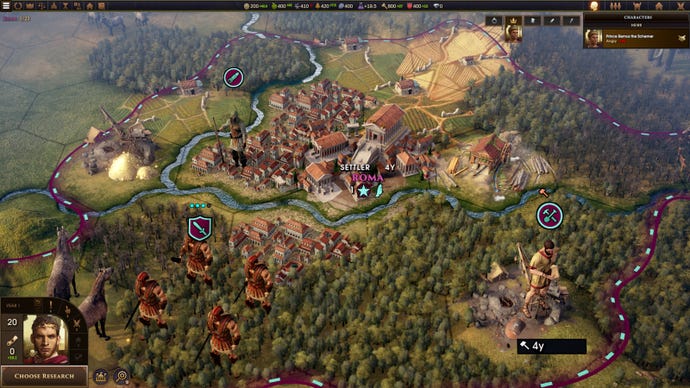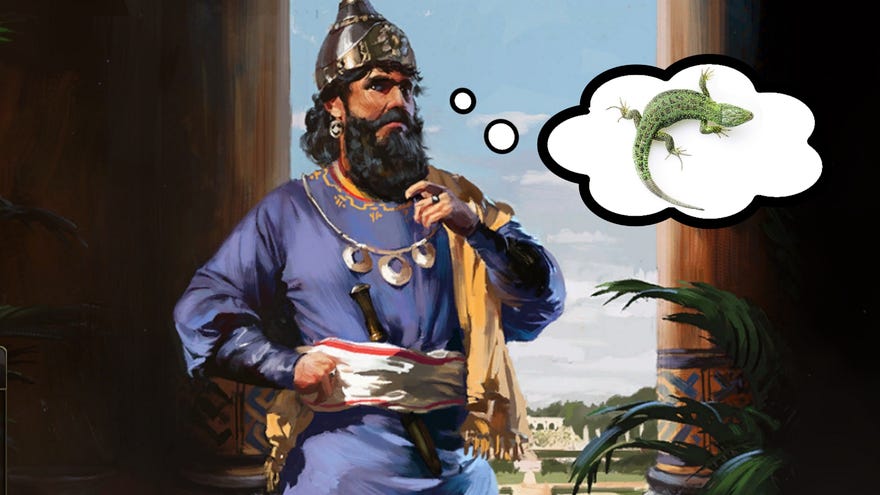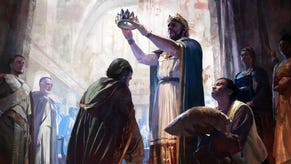Old World is almost the perfect blend of Civilization and Crusader Kings III
Don't sleep on it. Also, lizards
If you like 4X games and you haven’t tried Old World yet, you should definitely have a play. While Humankind has been attracting a lot of attention as the upcoming Pepsi to Civilization’s coke, you might not have been aware of this quiet, beautiful little bottle of Dr Pepper, which has been brewing away in early access for the best part of a year. It launched in full last week - and having been playing on and off since then, I want to do a big recommend of it to you. To begin this recommendation, I will resort to my time-honoured tradition of a seemingly irrelevant animal fact, which swerves suddenly into a metaphor.
Lizards. We all love ‘em, we all respect ‘em. But sometimes, you just want another reptile to think about. The closest alternative most people reach for is a creature known as a snake, or “stretch lizard” (which is basically the same as a normal lizard but with the legs binned and teeth that shoot poison). Snakes are cool.

But what about the tuatara? He’s a little green bloke; lives in New Zealand. About the size of a shoe. That’s one in the picture on the right, there. You’re probably scoffing at me ‘cos it looks like it’s just a lizard, but it’s not. The tuatara is the sole representative of its own branch of reptilia, sitting a few tables away from the lizards in the Linnaean lunch hall. It has barely changed in 240 million years, and it is a very strange lad indeed.
Tuataras can casually live a couple of centuries, like they somehow can’t be arsed to die. They dwell in holes, with seabirds as flatmates, and they have a light-sensitive third eye beneath the skin on the top of their skulls. That’s unreasonable. Indeed, despite presenting no threat to humans whatsoever, tuatara were traditionally understood by the Māori to be emissaries of the god of death, purely because their vibes are so aggressively unusual.
And so to Old World. It is extremely difficult for a 4X game to look like anything other than a generic 4X game - or specifically, the genre-definer Civilization and its scions - at first glance. Old World, as Steve Hogarty expressed beautifully in his early access review, is no exception. But once you get to grips with it, you soon find this is no ordinary lizard. Much like the tuatara with its ultra-weird subdermal peeper, Old World conceals a whole different nature.

What is it, then? For my first couple of games, even having played an early build some while ago, I didn’t have a clue. There were about a billion different resources, and I was constantly having to make decisions about which to accumulate most of, despite having little idea of their comparative values. In addition, there was a sort of Crusader Kings business going on, with vengeful aunts, hunting trips gone awry, and a whole royal personal life to manage on behalf of my ruler.
Honestly, I’d advise you not to get invested in your first few goes at Old World. Don’t try to win, as you’ll only get confused. Just dick about, making decisions based entirely on intuition, and concentrate on getting an instinct for what happens as a result of them. Sooner or later, the game will click for you - you’ll understand how the resources behave in the longer term, and how you can take advantage of them to force your way to the situations you want to be in.
Each of your rulers must decide on lifetime ambitions, such as “build seven cities” or “eat one million crisps”.
Essentially, Old World is a trading game. Each of your rulers (for in another parallel to Crusader Kings, you play as the successive holders of a throne) must decide on lifetime ambitions, such as “build seven cities” or “eat one million crisps”. Completing an ambition doesn’t just further your progress on the victory score track. It also increases your “legitimacy” statistic, which as well as making you generally more effective, confers a major boost to another stat: orders.
The number of orders you receive per turn is, when it comes down to it, the most important number in the game. It prescribes how many things can be done, with each order convertible to one unit move, one attack, one turn of tile improvement work, one unit upgrade, and so on. The more orders you have, the greater the proportion of your machinery of empire that can be grumbled into action each turn.

As such, then, when your ruler gets an ambition, you pivot all your efforts into trying to achieve it. And in a beautiful feedback loop, the more legitimacy you have, the more fully your civilization can be turned to the goal in question. It's a cracking design. But it’s no easy business to master. What at first seems like an obvious beeline to an objective, may often turn out to be a route so inefficient that other areas of development are entirely neglected - areas which may prove crucial to achieving the new ambitions which can crop up at any moment.
This is where the trading comes in. Say you’re set on building those seven cities, for example. Rather than spamming settlers, you might choose to build workers instead, who go on to build quarries, upping your stone generation. With that stone, you build urban improvements, which increase your civics generation, allowing you to pass a major law which provides you with a free settler unit. In the time it would have taken you to build the settler, you’ve shored up several other stat-generators... and when your king then decides his next ambition is to build something costing a load of stone, you feel well smug.
And so on. There are thirteen resources in the game, all of which behave completely differently, and dozens of mechanics by which they can influence each other. In fact, it’s not a world away from developer Mohawk’s last game, Offworld Trading Company, which rested on similar design principle bedrock. And it works really well here. In my last post about Humankind, the other big Civ competitor I’ve got my eye on, I lamented the tendency for 4X games to gravitate towards obvious choices, in a genre which is at its richest when it swamps you in dilemmas. Old World manages to avoid that artfully, with virtually every decision it throws at you requiring some degree of lateral thinking and head-scratching.
Old World is arguably the cleverest of the boxers slugging it out for the historical 4X crown. But how fun is it? Not quite as fun, perhaps. No matter how you slice it, there is a lot of maths in this cake. And Old World is, in my experience so far, a lot slower to play than Civ or Humankind. Pretty much the whole game takes place within the first two historical eras covered by those others, and despite a wealth of features to help shorten the 200 turns in a game, they still take a goodly while to pass. It’s certainly not dry, but it’s more about patience and cogitation than quick rewards, with a great freight of factors to consider at each turn.

Also, while the writing is both ample and excellent, at times I find the game’s roleplaying element slightly at odds with the rest of it. The interactions you have with your own family, the other great families in your empire, and the other empires’ leaders are interesting and rewarding, for sure. It’s impressive as crikey that Mohawk have come up with a robust, if simplified, answer to Crusader Kings at the same time as making their not-so-Civlike. But you can’t honestly roleplay when character interactions serve as one more route through which to make a profitable exchange of integers. Interesting stories are generated nonetheless, but they unfold according to the blueprints of expedition, rather than of whim.
I am, suddenly, not sure it’s a good idea to set so much stock in a game’s ability to eat the rest of your life by exploiting busted hominid brain wiring.
It’s usually at this point in commending a 4X game that the “one more turn” factor gets discussed. But I had a bit of an epiphany on this, recently. I am, suddenly, not sure it’s a good idea to set so much stock in a game’s ability to eat the rest of your life by exploiting busted hominid brain wiring. Imagine if booze adverts described “that ‘one more drink’ factor”, or if wine reviewers wrote gushingly about a vintage’s potential to turn your life into a shivering nightmare of dependence. I dunno, just a thought.
Which all leads me to assuring you that Old World is still compulsive, if that’s what you’re after. Nevertheless, it’s heavier on the thinkbag than similar games are, and I often find sessions ending after a completely reasonable amount of time, as my brain decides it might be nicer not to grind itself against dozens of fluctuating, abstract metrics for a bit. And do you know what? That might be no bad thing at all.
NB - for those about to comment regarding my views on snakes in paragraph two: yes, I know the difference between venom and poison. And about legless lizards. Sometimes, accuracy must be sacrificed for a more pleasing sentence. You will never defeat me in the arena of reptiles.






